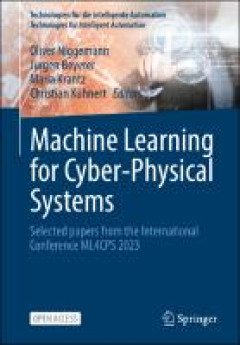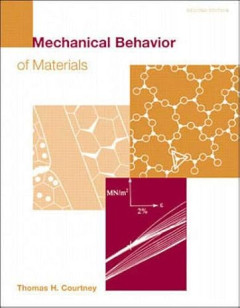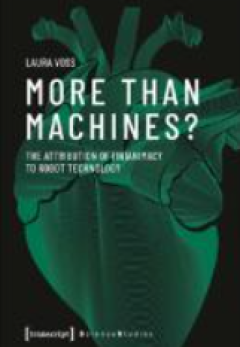Ditapis dengan

E-book Machine Learning for Cyber-Physical Systems: Selected papers from the …
This open access proceedings presents new approaches to Machine Learning for Cyber-Physical Systems, experiences and visions. It contains some selected papers from the international Conference ML4CPS – Machine Learning for Cyber-Physical Systems, which was held in Hamburg (Germany), March 29th to 31st, 2023. Cyber-physical systems are characterized by their ability to adapt and to learn: They…
- Edisi
- -
- ISBN/ISSN
- 9783031470622
- Deskripsi Fisik
- 130 halaman
- Judul Seri
- -
- No. Panggil
- 620.001 NIG m

Mechanical Behavior of Materials, 2nd Edition
This book presents a comprehensive treatment of the principles of the mechanical behavior of materials. Appropriate for senior and graduate courses, Mechanical Behavior of Materials is distinguished by its focus on the relationship between macroscopic properties, material microstructure and fundamental concepts of bonding and crystal structure. Courtney's second edition brings the reader up-to…
- Edisi
- -
- ISBN/ISSN
- 9780070285941
- Deskripsi Fisik
- 752 halaman, 18,5 x 23,5 x 3 cm
- Judul Seri
- -
- No. Panggil
- 620.1 COU m
Materials Science and Engineering : An Introduction
Materials are probably more deep-seated in our culture than most of us realize. Transportation, housing, clothing, communication, recreation, and food production virtually every segment of our everyday lives is influenced to one degree or another by materials. Historically, the development and advancement of socities have been intimately tied to the members's ability to produce and manipulate m…
- Edisi
- -
- ISBN/ISSN
- 0471320137
- Deskripsi Fisik
- xxi + 871 hlm; 21 x 26 cm
- Judul Seri
- -
- No. Panggil
- 620.11 JUN m
Principles of Electrical Engineering Materials and Devices
Understanding the basic building blocks of matter has been one of the most intriguing endeavors of mankind. Our understanding of interatomic interactions has now reached a point where we can quite comfortably explain the macroscopic properties of matter, based on quantum mechanics and electrostatic interactions between electrons and ionic nuclei in the material. There are many properties of mat…
- Edisi
- -
- ISBN/ISSN
- 0071164715
- Deskripsi Fisik
- xii + 690 hlm; 18 x 23 cm
- Judul Seri
- -
- No. Panggil
- 621.31 KAS p
E-book Human Factors in Privacy Research
Warren and Brandeis [23] cite the judge Thomas M. Cooley when making this statement and refer to a section on bodily integrity in his book [6, p. 29] where the original quote reads “The right to one’s person may be said to be a right of complete immunity: to be let alone”[6, p. 29]. However, Cooley mainly refers to the integrity of the h…
- Edisi
- -
- ISBN/ISSN
- 9783031286438
- Deskripsi Fisik
- 380 hlm
- Judul Seri
- -
- No. Panggil
- 620.8 GER h

E-book Advancing IoT Platforms Interoperability
The IoT European Platforms Initiative (IoT-EPI) projects are address-ing the topic of Internet of Things and Platforms for Connected Smart Objects and aim to deliver an IoT extended into a web of platforms for connected devices and objects that supports smart environments, businesses, services and persons with dynamic and adaptive configu-ration capabilities. The specific areas of …
- Edisi
- -
- ISBN/ISSN
- 9788770220064
- Deskripsi Fisik
- 91 hlm
- Judul Seri
- -
- No. Panggil
- 621.382 SCH a

Land Use Cover Datasets and Validation Tools : Validation Practices with QGIS
This chapter sets out the aims of this book and explains themethods and approaches applied in its production. It alsoaspires to be a guide, offering readers instructions as to howbest to use the book. We therefore strongly encourage allreaders to read this chapter carefully, so as to gain a clearerunderstanding of all the different aspects analysed in thisbook. This chapter also provides essent…
- Edisi
- -
- ISBN/ISSN
- 9783030909987
- Deskripsi Fisik
- 459 hlm
- Judul Seri
- -
- No. Panggil
- 624 OLM l
E-book Building Industries at Sea - ‘Blue Growth’ and the New Maritime Ec…
For thousands of years the oceans have been highly prized and have providedus with efficient transport and a plentiful supply of food. Therefore, it seemsobvious that our modern society should continue to use the oceans andmaximize the benefits. There might be great treasures of valuable materials,new bio-compounds and endless energy. However society is reluctant tochange an…
- Edisi
- -
- ISBN/ISSN
- 9788793609266
- Deskripsi Fisik
- 515 hlm
- Judul Seri
- -
- No. Panggil
- 621.042 ROB b

E-book More Than Machines? : The Attribution of (In)Animacy to Robot Technology
Robots have the connotation of a futuristic technology. In fact, however, theyhave been around for quite a while: Simple self-operating machines,so-calledautomata, existed already in ancient Greece, and the manufacturing tradi-tion continued on into medieval times (Truitt, 2015). In the fifteenth century,Leonardo da Vinci drew plans for a humanoid robot (Moran, 2006), and inthe eighteenth centu…
- Edisi
- -
- ISBN/ISSN
- 9783839455609
- Deskripsi Fisik
- 217 hlm
- Judul Seri
- -
- No. Panggil
- 670.42 VOS m

E-book Trust in Robots
Human-Robot Interaction (HRI) is a multidisciplinary research field that integrates disciplines such as engineering, psychology, sociology, philosophy, and more1. Collaboration between different disciplines is necessary to achieve goals (such as developing robotic systems for human-aware navigation), but can be com-plicated as each discipline has a different jargon, uses different methods, and …
- Edisi
- -
- ISBN/ISSN
- 9783854480525
- Deskripsi Fisik
- 310 hlm
- Judul Seri
- -
- No. Panggil
- 629.8 FRI t
 Karya Umum
Karya Umum  Filsafat
Filsafat  Agama
Agama  Ilmu-ilmu Sosial
Ilmu-ilmu Sosial  Bahasa
Bahasa  Ilmu-ilmu Murni
Ilmu-ilmu Murni  Ilmu-ilmu Terapan
Ilmu-ilmu Terapan  Kesenian, Hiburan, dan Olahraga
Kesenian, Hiburan, dan Olahraga  Kesusastraan
Kesusastraan  Geografi dan Sejarah
Geografi dan Sejarah